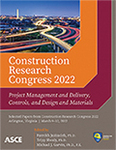Fairly Apportioning Concurrent Delay Liability: A Game Theory Approach
Publication: Construction Research Congress 2022
ABSTRACT
Concurrent delay is a vexing problem at the intersection of construction scheduling and contract law that has long been studied to determine time extensions, compensable delays, and apportion liquidated damages among project participants. Nevertheless, there is no standard delay analysis method that fairly apportions such liabilities for activities that are parallel. This study presents a formal approach using game theory to transparently analyze and fairly apportion delays among stakeholders including owners, contractors, and especially subcontractors. Its four-steps employ the Shapley value, a cooperative game solution concept. Step 1 acquires as-planned and as-built schedules as input; step 2 classifies delayed activities; step 3 determines marginal contribution and probabilities; and step 4 calculates the Shapley value for each player to indicate its liability. Examples for two players and three players illustrate the detailed working of the new model. The contribution of this research is a comprehensive, fair, and simple solution for concurrent delays.
Get full access to this article
View all available purchase options and get full access to this chapter.
REFERENCES
Abdelhadi, Y. F. J. (2015). Common Delay Analysis Methods and Factors Influencing the Selection of Such Methods in Construction Projects in UAE. Thesis, British University in Dubai, United Arab Emirates.
Al-Gahtani, K. S. (2006). A Comprehensive Construction Delay Analysis Technique – Enhanced with a Float Ownership Concept. Dissertation, Department of Civil, Structural, and Environmental Engineering, State University of New York at Buffalo.
Arcuri, F. J., and Hildreth, J. C. (2007). The Principles of Schedule Impact Analysis., Department of Civil and Environmental Engineering, Virginia Polytechnic Institute and State University, Blacksburg, VA.
Arditi, D., and Pattanakitchamroon, T. (2006). “Selecting a delay analysis method in resolving construction claims.” International Journal of Project Management, 24(2): 145–155.
ASCE. (2017). Schedule Delay Analysis. ASCE Standard ANSI/ASCE/CI 67-17. American Society of Civil Engineers, Reston, VA.
Asgari, S., Afshar, A., and Madani, K. (2014). “Cooperative game theoretic framework for joint resource management in construction.” Journal of Construction Engineering and Management, 140(3), 04013066(13).
Baram, G. E. (2000). “Concurrent delays – what are they and how to deal with them?” Transactions of AACE International, CDR.07.01-CRD.07.08.
Braimah, N. (2013). “Construction delay analysis techniques—A review of application issues and improvement needs.” Buildings, 3(3): 506–531.
Casinelli, M., and de Angelis, A. (2007). “Concurrent Schedule Delay Between Main Contractor and Subcontractor.” Transactions of AACE International, INT.03.1-INT.03.8.
DeFlaminis, W. A. (2015). Practical tips on concurrent delay. February 9, 2015, <www.americanbar.org/groups/litigation/committees/construction/articles/2015/winter2015-practical-tips-concurrent-delay>(November 30, 2020).
Doyle, J. (2007). “Concurrent Delays in Contracts.” Australian Construction Law newsletter, 112(January/February), 22-27. <http://138.25.65.17/au/journals/AUConstrLawNlr/2007/5.pdf>(June 4, 2021).
Eissa, R., Eid, M. S., and Elbeltagi, E. (2021). “Conceptual Profit Allocation Framework for Construction Joint Ventures: Shapley Value Approach.” Journal of Management in Engineering, 37(3), 04021016(13).
Eriksson, P. E. (2007). “Cooperation and partnering in facilities construction – empirical application of prisoner’s dilemma.” Facilities, 25(1/2): 7–19.
Garcia, M. V. A. (2019). A Comparative Analysis and Evaluation of Existing Construction Delay Analysis Methods Based on Critical Path Network. Thesis, Department of Civil and Environmental Engineering, Catholic University of America.
Golnaraghi, S. (2011). Development of Delays Claims Assessment Model. Thesis, Department of Building, Civil, and Environmental Engineering, Concordia University.
Gondia, A., Siam, A., El-Dakhakhni, W., and Nassar, A. H. (2020). “Machine Learning Algorithms for Construction Projects Delay Risk Prediction.” Journal of Construction Engineering and Management, 146(1): 04019085(16).
Hinze, J. W., and Tracey, A. (1994). “The Contractor-Subcontractor Relationship: The Subcontractor’s View.” Journal of Construction Engineering and Management, 120(2): 274–287.
Ho, S. P. (2006). “Model for Financial Renegotiation in Public-Private Partnership Projects and Its Policy Implications: Game Theoretic View.” Journal of Construction Engineering and Management, 132(7): 678–688.
Ho, S. P., and Liu, L. Y. (2004). “Analytical Model for Analyzing Construction Claims and Opportunistic Bidding.” Journal of Construction Engineering and Management, 130(1): 94–104.
Ibbs, C. W., Nguyen, L. D., and Simonian, L. G. (2011). “Concurrent Delays and Apportionment of Damages.” Journal of Construction Engineering and Management, 137(2): 119–126.
Kao, C. K., and Yang, J. B. (2009). “Comparison of windows-based delay analysis methods.” International Journal of Project Management, 27(4): 408–418.
Medda, F. (2007). “A game theory approach for the allocation of risks in transport public private partnerships.” International Journal of Project Management, 25(3): 213–218.
Mehany, M. S. H. M. (2014). Delay-Caused Claims in Infrastructure Projects under Design-BidBuild Delivery Systems. Dissertation, Department of Civil and Environmental Engineering, Colorado State University.
Nguyen, L. D., and Ibbs, C. W. (2008). “FLORA: New Forensic Schedule Analysis Technique.” Journal of Construction Engineering and Management, 134(7): 483–491.
Ponce de Leon, G. (1987). “Theories of concurrent delays.” AACE Transactions, 6: 1–5.
Sedky, A. F. (2017). Selecting the Best Delay Analysis Technique. <www.projectmanagement.com/articles/365314/Selecting-the-Best-Delay-Analysis-Technique>(November 30, 2020).
Shapley, L. S. (1953). “A value for n-person games.” Contributions to the Theory of Games II, eds. Kuhn, H., Tucker, A., Princeton University Press, Princeton, NJ: 307–317.
Information & Authors
Information
Published In
History
Published online: Mar 7, 2022
Authors
Metrics & Citations
Metrics
Citations
Download citation
If you have the appropriate software installed, you can download article citation data to the citation manager of your choice. Simply select your manager software from the list below and click Download.
